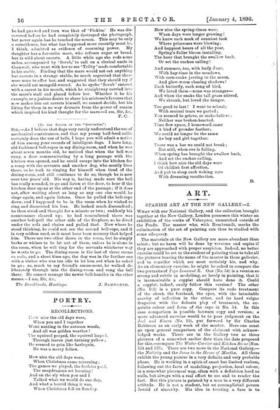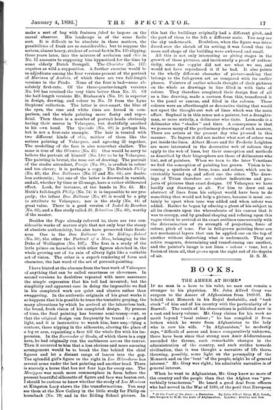ART.
SPANISH ART AT THE NEW GALLERY.—I.
WHAT with our National Gallery, and the collection brought together at the New Gallery, London possesses this winter am exhibition of the works of Velazquez, unmatched outside of the Prado. The master who, with Rembrandt, marks the culmination of the art of painting can thus be studied with some adequacy.
The materials at the New Gallery are more abundant than, select; but no harm will be done by versions and copies if they are approached with proper suspicion. Indeed, no better exercise could be set to the student of painting than to take all the pictures bearing the name of the master in these galleries,. and to consider which are most certainly his, and why. As an elementary exercise, he might be asked to compare the two portraits of Pope Innocent X. One (No. 54) is a version so strong and subtle in modelling, so lovely in painting, that it is inconceivable a copyist should have done it. Could a copyist, indeed, easily follow this version ? The other (No. 102) is a poor copy. Compare its rude treatment of the cheek, the forehead, the eyes, with the inimitable suavity of inflection in the other, and its hard vulgar draperies with the delicate play of treatment, the ex-- quisite colour and form of the cape in No. 54. In this case comparison is possible between copy and version; a more advanced exercise would be to pass judgment on the Ice! and Sisera (No. 12), put forward by Sir Charles Robinson as an early work of the master. Here one must go upon general comparison of the claimant with acknow- ledged works. There are in the Gallery two or three pictures of a somewhat earlier date than the date proposed for this,—compare The Water Carrier and Kitchen Sane (Nos. 134 and 135). There are two more in the National Gallery,— the Nativity and the Jesus in the House of Martha. All these exhibit the young painter in a very definite and very probable phase. He is working in a spirit of exact but limited realism) following out the facts of modelling, projection, local colour,. in a somewhat piecemeal way, often with a definition hard as nails, but always with a real effort to see and to render the fact. But this picture is painted by a man in a very different attitude. He is not a student, but an accomplished person devoid of sincerity. His idea in treating a face is to,
make a sort of bag with features faked to impose on the casual observer. His landscape is of the same facile sort. It is difficult to be absolute in these matters, the possibilities of freak are so considerable; but to suppose the serious, almost heavy, student of actual fact in No. 135 slipping, three years later, into the mixture of archaism and chic in No. 12 amounts to supposing him hypnotised for the time by some elderly Dutch Svengali. The Chorister (No. 117) requires as wild a supposition. A further exercise would be to adjudicate among the four versions present of the portrait of Mariana of Austria, of which there are two full-length versions in the Prado. None of the four is bad—none ab- solutely first-rate. Of the three-quarter-length versions No. 106 has retained the rosy tints better than No. 55. Of the half-length versions Mr. Brabazon's (No. 19) is superior in design, drawing, and colour to No. 79 from the Lyne Stephens' collection. The latter is over-smart, the blue of the eyes, the rose and white tints are forced in com- parison, and the whole painting more flashy and super- ficial. Then there is a number of portrait heads obviously having their source in Velazquez, but doubtfully ascribed to his own hand. The Quevedo (No. 68) is perhaps his, but is not a first-rate example. The hair is treated with two different kinds of chic, neither of them like the serious painting of Velazquez, and agreeing ill together. The modelling of the face is also somewhat shallow. The same is true of the Olivarez (No. 45). One would be sorry to believe the portrait of himself (No. 140) to be by Velazquez. The painting is brutal, the nose out of drawing. The portrait of the studio attendant, Pareja (No. 98), is crudish in colour and too clever; it is perhaps a copy. The Dulwich Philip (No. 43), the Don Baltasars (No. 57 and No. 64), are doubt- less authentic ; but one of the latter is drowned in varnish, and all, whether by time or ill-usage, have a rather obliterated effect. Look, for instance, at the hands in No. 43. Mr. Huth's full-length Philip (No. 74) it is impossible to see pro- perly; the infant Don Baltasar (No. 48) it would be a pity to attribute to Velazquez ; nor is the study (No. 4.4) of great value. There is a good version of Isabel de Bourbon ;No. 63), and a fine study called St. Sebastian (No. 69), worthy of the master.
Besides the Pope already referred to, there are two con- siderable works of mature style that not only bear the stamp of absolute authenticity, but also have preserved their fresh- ness. One is the Don Baltasar in the Riding - School (No. 59), the other the Portrait of a Man, belonging to the Duke of Wellington (No. 107). The first is a study of the little prince on horseback with other figures sketched in, the whole growing out of its rain of silvery light like a veritable act of vision. The other is a superb rendering of form and character, the last word of the art of portrait-painting.
I have hinted at the absence from the best work of Velazquez of anything that can be called smartness or cleverness. In second versions he doubtless repeated with more assurance the simple expression that his toil had invented; but the simplicity and apparent ease in doing the impossible we find in his completed work are quiet and elusive rather than swaggering. In the authentic originals of his great works it so happens that it is possible to trace the tentative groping, the many alterations by which he arrived at the labourless look, the broad, fresh vision of his completed design. By process of time, the final painting has become semi-transp rent, so that the original design can frequently be traced i o a good light, and it is instructive to watch him, here amphfying a contour, there nipping in the silhouette, altering the place of a leg or arm, repainting a face till the whole fits with his im- pression. In the Surrender of Breda, of which there is a copy here, he had originally run the carbineers across the canvas. Then it occurred to him that a less obvious and more amusing arrangement would be to break the line behind the chief figures and let a distant range of lances into the gap. The splendid girl's figure to the right in Las Hilancleras has several arms under the last painting and another head. There is scarcely a horse that has not four legs for every one. The Menippus was much more commonplace in form before the present beautiful silhouette of figure and face was beaten out. I should be carious to know whether the study of Lag .Afeninas at Kingston Lacy shows the like transformations. You may see them at the New Gallery in the little study for Philip on horseback (No. 78) and in the Riding School picture. In this last the buildings originally had a different pitch, and the part of them to the left a different scale. You may see the sky underneath. Doubtless, when the figure was intro- duced over the sketch of its setting, it was found that the mass and shape of the building were awkward and small.
All this is not only interesting as giving stages in the growth of these pictures, and incidentally a proof of authen- ticity, since the copyist did not see what we see, and would not have reproduced it if he had. It also points to the wholly different character of picture-making that belongs to the full-grown art as compared with its earlier phases. Painters of earlier schools thought of their pictures on the whole as drawings in line filled in with tints of colour. They therefore completed their design first of all as a line drawing, made a cartoon from this, transferred it to the panel or canvas, and filled in the colours. These colours were an afterthought or decorative tinting that would not upset the thought-out web of lines which was the main affair. Raphael is in this sense not a painter, but a draughts- man, or more strictly, a delineator who tints. Leonardo is a delineator who " shades " and tints. A consequence is that we possess many of the preliminary drawings of such masters. There are artists at the present day who proceed in this manner. To Ingres it did not matter what sort of colour was put inside the lines. Albert Moore and Sir Frederic Leighton are more interested in the decorative web of colours they apply to the web of lines, but their conception and methods as described by their biographers are those of delineators who tint, not of painters. When we turn to the later Venetians we find the conception of painting has grown. Vision is be- coming a synthesis of form, tone, and colour, which are in- extricably bound up, and affect one the other. The draw- ings of Titian therefore are rather indications and pro- jects of pictures than exact designs. Of Velazquez we have hardly any drawings at all. For him to draw out an abstract of lines from his subject would have been to do something that would not help a picture, because it must cer- tainly be upset when tone was added and when colour was added. Rather he began by educing a ghost of his subject in all its elements upon the whereabouts of his canvas that it was to occupy, and by gradual shaping and refining upon this vague vision he arrived at its exact outlines concurrently with the determination of its strength of projection, force of colour, pitch of tone. For in full-grown painting these are not mechanical layers that can be applied one on the top of another without disturbing what is underneath. They are active reagents, determining and transforming one another, and the painter's image is not lines + colour + tone, but a fusion of them all, that grows upon the sight out of the depths















































 Previous page
Previous page